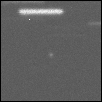 3.0 Outer Planet Satellite Astrometry
3.0 Outer Planet Satellite Astrometry 3.0 Outer Planet Satellite Astrometry
3.0 Outer Planet Satellite AstrometryWe have recently moved to a wide-field CCD system in conjunction with IRAF. Here is an abstract from AAS 187:
In March 1994 our long standing program of astrometric observations of faint solar system objects at McDonald Observatory moved from a Cassegrain focus photographic plate camera on the 2.1 m telescope to an f/3 Prime Focus Corrector (PFC) and CCD system on the 0.76 m telescope. The PFC has an unvignetted 1.1 degree field of view, a flat focal surface with 0.01% distortion, and a spectral band width from 300 nm to 1100 nm. The present detector is a MetaChrome II-coated, Loral-Fairchild 2048x2048 CCD that covers a 46 arcmin by 46 arcmin area with 1.35 arcsec pixels. This instrument is capable of reaching R=21.5 with 3-sigma significance on stellar objects, in single 15 minute integrations. Optical, mechanical, and electronic improvements, now underway, will produce almost a 1 magnitude improvement in sensitivity and will increase data accuracy and precision. The HST Guide Star Selection System Catalog Version 1.1 is used as the astrometric reference catalog. We are working with other groups to improve the astrometric accuracy of results based on this catalog. Our observing program now concentrates on NASA asteroid and comet mission support (e.g. 433 Eros, 253 Mathilde, and 1620 Geographos), near-Earth objects, asteroids in peculiar regions of the main belt (e.g. the 3:1 resonance), and the natural satellites of the outer planets. We observe approximately three nights per month. A cloudless night results in some 75 exposures of 50 or more different objects. Minor planet and comet observations are reduced, measured, and reported to the Minor Planet Center within one week. Natural satellite results are segregated by primary and appear in the standard literature on an opposition basis. To date (10/26/95), we have obtained 722 observations of minor planets, 25 of comets, and 480 of natural satellites with the PFC/0.76 m telescope combination. The 1-sigma accuracy of the derived positions is approximately 0.5 arcseconds.